No products in the cart.
Oca (Oxalis tuberosa)
Overview
- Oca is a tuber crop native to the Andes, where it was developed alongside the similar tuber crops potato, ulluco, and mashua.
- Oca tubers are usually long and narrow, reaching about four inches in length.
- This crop is easy to grow in most of the Pacific Northwest, but challenging in the rest of the country.
- Yields can reach about three pounds per plant in favorable climates, but are usually lower.
- The tubers are vividly colored, mostly in reds, yellows, and oranges, and often have contrasting eyes.
- Cooked tubers are somewhat softer than potatoes and have a variety of flavors, from mild to acidic and a bit sweet to starchy.
- Oca is roughly as tolerant to summer heat as potato; it does best where temperatures don’t exceed 80 degrees too often.
- Tubers are produced during the short days of fall and are not ready for harvest until mid-November.
- The crop is propagated by planting tubers. True seeds are produced only under favorable conditions and are used for breeding.
- Oca typically has less problems with disease than potatoes, although this is not true everywhere.
This guide provides information about growing oca in North America, and particularly the Pacific Northwest, which is the only place that I have experience growing it. Much of the information will apply anywhere, but considerations about the timing of planting and harvesting, climate, photoperiod, and pests and diseases will vary considerably by location.
About Oca
Description
Oca (Oxalis tuberosa, formerly Oxalis crenata), pronounced OH-kuh, is a member of the widespread family Oxalidaceae, the wood sorrels, and should look somewhat familiar to woodland foragers all over the world. It is known by many names in its native South America, but in the rest of the world it is probably most commonly known as the New Zealand Yam (or, if you are in New Zealand, simply as yams). Botanically, it has no close relationship to actual yams, so this is all potentially confusing. Let’s stick to calling it oca.
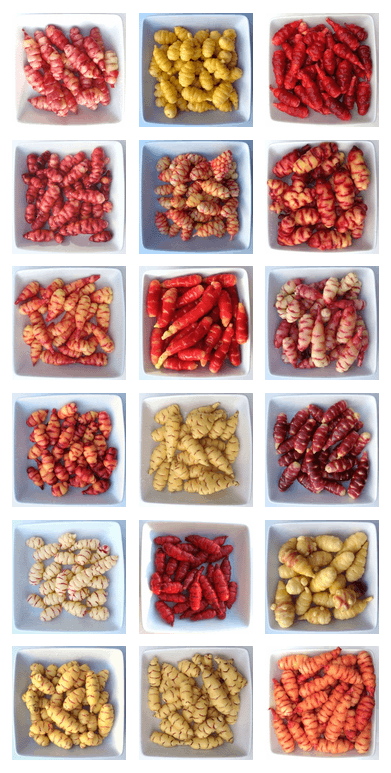
Oca has thick, succulent stems and clover like leaves. Plants grow up to about 18 inches (45 cm) tall, although the stems frequently sprawl before this point, and up to three feet (91 cm) in diameter, although usually closer to two feet (61 cm). They are fast growing in cool, wet weather and are generally able to outcompete and smother weeds. Because it is attractive and has a long growing season, it can make a good decorative vegetable.
Underground, the plant forms tubers that reach a maximum size of about eight inches (20 cm) in length and an inch and a half (4 cm) in width, although most commonly about half this size. The tubers are usually colorful and have a shiny, waxy skin that cleans easily. Tubers cluster relatively closely under the base of the plant, with some ranging out on stolons to about a 1 foot (30 cm) radius. A yield of 1lb (453 g) per plant is a pretty good result for North America, although this would be considered poor in the Andes. Some varieties have better yields than others and some bulk up more quickly. Yields in excess of 2lb (900 g) per plant are possible with the right varieties, a long season, and good management.
Oca is a perennial due to regrowth from tubers, but it has an annual lifecycle and senesces in winter where it is not killed by frost. It is fairly easy to grow oca in the maritime Pacific Northwest and coastal California, where frost doesn’t threaten until the latter part of fall, if at all.
Oca is a polyploid crop, usually of octoploid configuration and it is probably an auto-allopolyploid. It may be the fusion of two tetraploids or a tetraploid with two diploid progenitors (Trognitz 2001). Tetraploid forms also exist and occasionally arise from seed. The tetraploids appear to be mostly yellow-white in color and may be synonymous with the group known as sour ocas, which are typically used to make traditional preserved products, rather than for fresh eating.
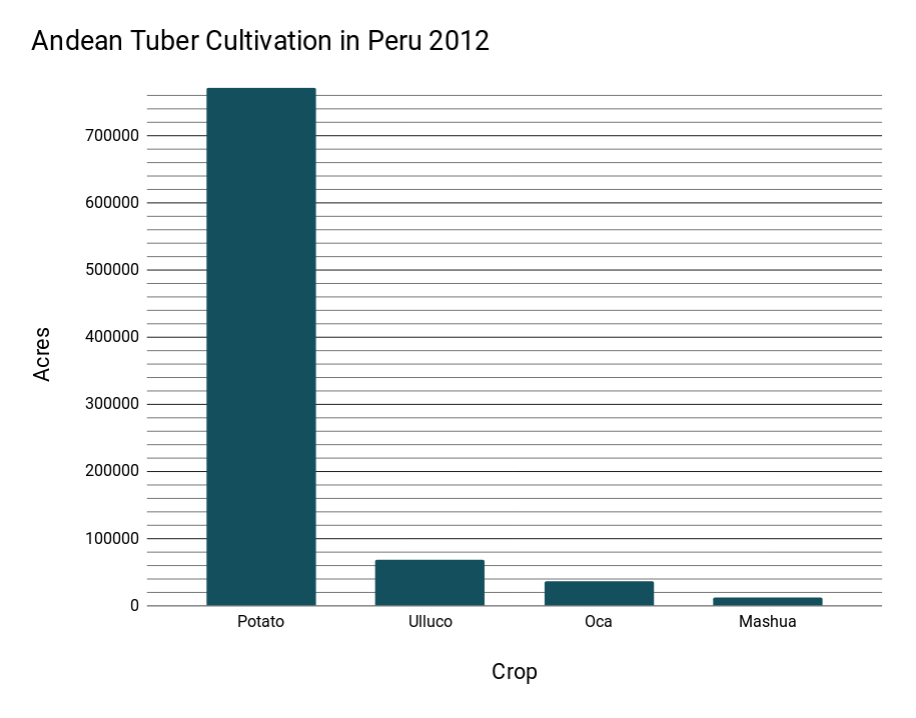
Hundreds of varieties exist in the Andes, although a considerable amount of genetic diversity has been, and continues to be, lost in its native range. Information is not available over its entire range but, in Ecuador, loss of varieties amounting to 33.3% of its previously assessed genetic variability has occurred in recent decades (Tapia 2001). Similar loss of genetic diversity has probably occurred throughout its range.
History
It is not known specifically how long oca has been cultivated, but it is likely that it long preceded the Incas and it may be one of the oldest Andean crops. It is grown up to 13,000 feet (4000 m) elevation, past the point where potatoes yield well and so is an important staple crop of high Andean peoples.
Molina identified oca in 1789 as O. tuberosa, a plant native to Chile. Jaques later identified it as O. crenata from Bolivian specimens in 1833. This became the accepted name for a while, but Molina was first, so O. tuberosa became the most accepted name again by the turn of the 20th century. Lesser known synonyms include Acetosella/Oxalis/Xanthoxalis crassicaulis, A. crenata, A./X. tuberosa, O. arracatcha/arracacha, O. chicligastensis, and O. melilotoides.

Oca was brought to the central highlands of Mexico in the mid to late 1700s and that became the first sustained crop outside the Andes. It is still grown there today, known as papa roja (red potato), papa de agua (watery potato), or papa ratona (mouse potato). Although oca was exported to Europe and the United States on many occasions, efforts to grow it were not sustained anywhere else until it gained a foothold in New Zealand in the latter half of the 19th century. (Although it did not become popular there until the 1970s.)
Oca was commonly grown in France as early as 1835 (Wisniak 2014). The French chemist Jean Louis Lassaigne produced perhaps the earliest nutritional analyses of two varieties in 1850 (Lassaigne 1850). It was introduced to Engliand and the US by the mid-1800s and appears to have been briefly popular as it appears in quite a few horticultural books of the period. It then mostly dropped out of sight until the 1950s.
Oca breeding outside the Andes was pioneered in the UK, beginning in 2007 (Smith 2009, Jan 22). This effort spawned the Guild of Oca Breeders in 2015, a collaborative amateur plant breeding initiative to produce better adapted varieties of oca for the UK.
Nutrition
Overall, oca is nutritionally similar to potato. It has about 20% less calories per serving and half as much protein, but carbohydrate content and fiber are similar. (There is actually considerable disagreement in the available sources about the calorie content of oca, with several papers giving a significantly lower number than I have used here. Estimates range from about 40 to 80 calories per 100 grams and the actual amount probably varies with variety and the amount of time that the tubers have been exposed to sunlight.)

Flores (2011) found the following vitamin and mineral values for oca:
Vitamin A: 0.99 IU/100g
Vitamin B1: 0.05mg/100g
Vitamin B2: 0.94mg/100g
Vitamin B3:1.09mg/100g
Vitamin B12: 0.91mg/100g
Vitamin C: 39.68mg/100g
Phosphorus: 28.2 mg/100g
Iron: 12.53 mg/100g
Calcium: 17.18 mg/100g
Zinc: 1.79 mg/100g
The sugars in oca consist of approximately 50% sucrose, 25% glucose, and 25% fructose in freshly harvested tubers (Hermann 2000).
Oca is significantly richer in vitamin C than potato, which is itself a good source of vitamin C, so oca is an excellent source. It is also very high in iron, although this may vary according to the iron content of the soil that it is grown in. Oca is probably a valuable source of nutritionally significant pigments, such as anthocyanins and carotenoids, the presence of which is indicated by the wide variety of colors found in oca skin and flesh. Varieties with dark colored flesh are presumably more valuable sources of these pigments.
Oca’s sour flavor is produced by oxalic acid, an antinutrient that is implicated in conditions such as kidney stones and gout. The levels of oxalic acid have been found to range from 80 to 200mg/100g (Martin 2005). This is roughly equivalent to levels found in garlic, carrots, Brussels sprouts, and snap beans, and less than rhubarb, chard, and spinach, so they should not pose any usual risk to most consumers, but oca should probably be avoided by those who are observing low oxalic acid diets. Oca is classified as only a moderate source of oxalic acid based on a study of its bioavailability, which was less than half that of spinach (Albihn 2001).
Although I have found no study that establishes their content, leaves and stems probably contain a greater portion of oxalic acid (they taste more acidic) and should probably not be consumed in large quantities, although most people wouldn’t be inclined to do so anyway.
Cooking and Eating
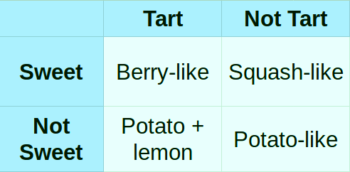
All parts of the plant can be eaten raw or cooked. The tubers are most the frequently consumed part. They can be eaten raw, most commonly after several days to a few weeks of exposure to the sun, which sweetens them. They can be cooked in any way that a potato can be cooked and can be readily used as a substitution in recipes that call for potatoes, carrots, and many other root vegetables.
Basic preparation is similar to that for potatoes. Most people will either boil or roast oca until fork tender. We usually drizzle with a little oil and roast at 350F. This can take 45 to 60 minutes depending on the size of the tubers. There is no need to peel oca, although peeling does reduce the tartness if that bothers you. It would be easier just to grow a variety that isn’t tart though or to wait for the tubers to sweeten in storage.
Exposure to sunlight alters the content of sugars and organic acids significantly. In one study, sucrose content more than doubled following exposure, while the acids glutarate and malate were reduced by half or more and soluble oxalate was reduced by about 15% (Hermann 2000). Boiling the tubers has not been found to reduce oxalate content, but the majority of the oxalate is found in the skin, so peeling oca prior to cooking should substantially reduce oxalate (Martin 2005). I don’t actually recommend this unless you are really worried about oxalate, because peeling the tubers is a fussy job and affects the flavor. We eat a lot of oca, we eat it unpeeled, and have never had a problem. There is no documented evidence of epidemics of kidney stones or gout among the Andean peoples who eat oca and most people tolerate soluble oxalate very well. Of course, I’m a plant breeder, not a doctor, so consult the relevant professionals if you have concerns.
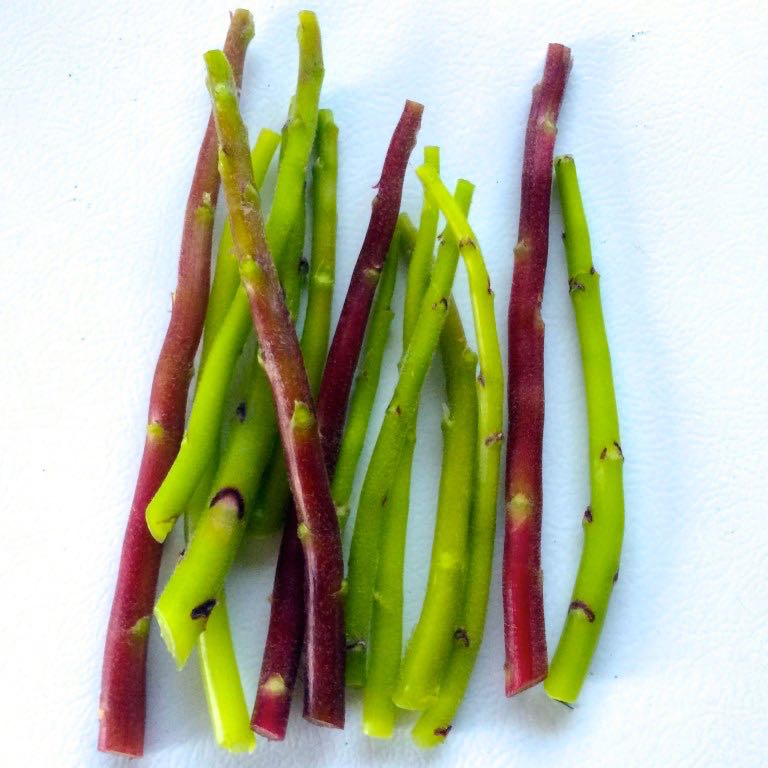
Flavors are subjective, but common descriptions of the cooked flavor of oca include a mix of potato and carrot, potatoes with sour cream, or even a flavor like winter squash. Oca flavor is primarily determined by the amount of sweetness and acidity or tartness of the variety. The most common description of oca flavor is potato with lemon or sour cream, which corresponds to ocas that are tart but not sweet. In the absence of sweetness and tartness, oca tastes very much like a potato. When both sweet and tart, it tastes something like combination of potato and berry. When sweet but not tart, it is more like a combination of squash and potato. Most varieties increase in sweetness with exposure to light or long storage.
Leaves can be eaten raw and provide a sour flavor similar to other sorrels. Stems are edible, although more tart than the tubers. We have found them to be a good substitute for rhubarb or gooseberries in pie. Flowers are small and mild tasting, but probably not worth the work to collect as food.
In the Andes, a marmalade is sometimes made from oca. Oca is also sometimes used to make a weak alcoholic drink, chicha de oca.
Like many vegetables, oca loses color when cooked. Unfortunately, not much of the color can be preserved, as it disappears very quickly. If you are boiling oca, acidifying the water can preserve more of the color – particularly the flesh color. Microwaving is the most effective way to cook oca while preserving some of its color.
Morphology
Although they are very diverse in shape and color, the appearance of oca tubers isn’t always enough to identify a variety. Two good traits that you can use to narrow down the possibilities are flower form and flower morph. Being able to identify the flower morph also becomes important when making crosses.
Cultivation
Climate Tolerance
In its native Andes, oca is grown from mid to high elevations, where temperature ranges from near freezing to nearly 80° F (27 C) during the growing season. Humidity is generally high, although there may be long periods of drought in terms of precipitation.
At low altitudes, oca performs best in cool, maritime climates, where it should be planted in full sun. It thrives where summer temperatures do not rise above 85° F (30 C) for long periods of time. It can tolerate daytime heat as long as the nighttime temperature falls into the low 70s (21 to 24 C) or lower. Although oca can tolerate some drought, best yields are achieved with plenty of water. Oca will do better in partial shade where temperatures frequently exceed 80° F. It may be able to tolerate temperatures up to 107F (41.6 C), for short periods of time (Peterson 2010), but I don’t recommend it.

For winter survival, oca best fits USDA zone 9a (low temperature of 20 to 25° F). Approximately half of the tubers can be expected to survive a multiple day freeze at 25° and approximately 25% at 20°. That said, most of zone 9a will be too hot in the summer for oca to perform well. Zone 9a in northern California and Oregon is ideal for oca. Zone 9a in Texas is not. Assuming that you will harvest your oca every year, you should be able to grow it successfully from roughly zones 7-9 with cooler summers.
In North America, oca grows well in all parts the Pacific Northwest, west of the Cascades, including SW British Columbia and southern Vancouver Island in Canada. It can be grown successfully east of the Cascades as well, with some shade at the height of summer and frost protection in the fall. It does well in coastal California, in the lower elevations of the Appalachians, and in upland Hawaii. It is actually fairly adaptable and will grow in quite a bit of the country given some shade in the summer and some frost protection in autumn. I have had reports of good yields around the Great Lakes, in Florida, Texas, and even Juneau, Alaska. In less ideal climates, success may vary considerably from year to year.
Photoperiod
Most oca varieties require short days of 12 hours or less for tuber formation. A few will form tubers at 12.5 or even 13 hours. Short days follow the autumn equinox (September 22nd or 23rd). Until that date passes, oca does not begin to form tubers. In most parts of its native Andean highlands, day length is always about 12 hours, so oca can produce a crop much more quickly. Oca needs six weeks to produce a reasonable harvest once the plants have reached full size. Advance six weeks from September 22nd and you are in the second week of November. That is how long you need to keep your plants alive and frost free. A reasonably large yield is generally produced by Thanksgiving. (American Thanksgiving, that is; sorry for getting your hopes up, Canadians.)
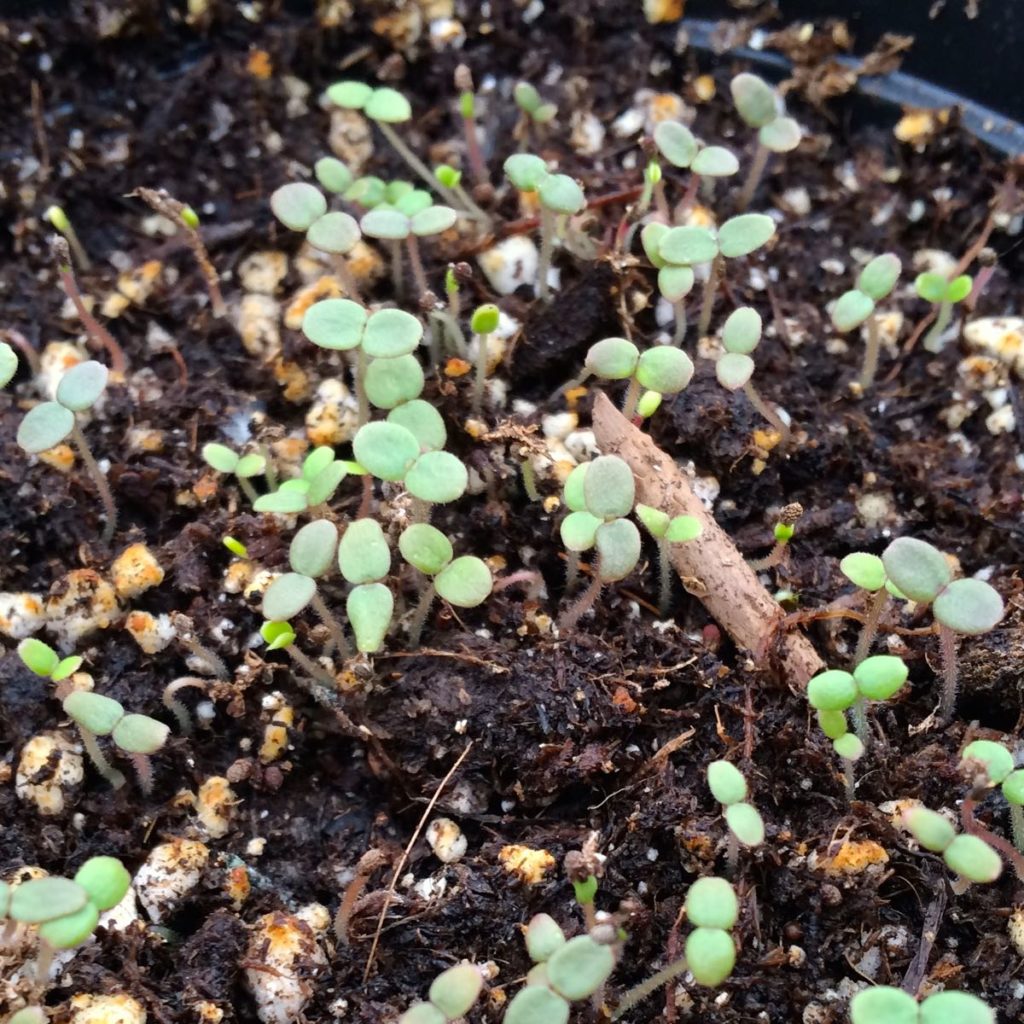
Although some sources appear to suggest their existence, I am aware of no day length neutral ocas, nor any that begin forming tubers at day lengths greater than 13 hours for that matter.
Soil Requirements
Oca thrives even in relatively poor soils, but loose, light soils benefit you at harvest time. A little complete organic fertilizer or compost should provide oca sufficient nutrition. High nitrogen fertilizers result in heavy top growth, but also appear to delay flowering, so if you are planning an oca breeding project, go easy on the nitrogen.
Almost any plot of decent garden soil will suffice. Oca prefers moderately acidic soils (pH 5.5 to 7) and will tolerate very acidic soil (pH <5.5) and even mildly basic soil (up to pH 7.5 or so).
Propagule Care
Tubers
Small tubers can suffer dehydration. Keep them in a dark, cool place. Check on them from time to time. If you find that they are becoming soft, either put them in some barely damp soil or in the crisper of your refrigerator.
Tubers kept at room temperature will usually begin to sprout by March. Sprouted tubers can wait to be planted for a month or more, so it is not an emergency. It is best to store the tubers where they can get some light, once they have sprouted; sprouts that grow in darkness will become spindly and fragile.
I recommend potting the tubers in some barely damp soil with the tip of the sprout exposed and then transplanting after the last frost. Oca is very tolerant about transplanting and you will get a head start by potting them. You don’t have to pot them individually; you can put a bunch in a single container and then divide them when you transplant.
 Seeds
Seeds
Oca seed has no dormancy and a fairly short lifespan. I have been tracking the germination rates of 2013 seed over five years. Seed stored at room temperature (about 65 degrees F here) showed a regular drop in germination over four years, ending at 8% in the fourth year of storage. Seed stored in the freezer also declined in germination, but by a very small amount in comparison. It is possible that retrieving the seeds and allowing them to warm up before freezing again might be possible for the small decline in germination. I won’t be able to track this any further as I ran out of 2013 seed in 2018.
Planting
Tubers or seedlings are typically planted out in the spring, any time after risk of frost has passed. They can be planted as late as August with good results in favorable (cool) climates (Pearson 2014, Mar 18). I don’t recommend late planting in warm climates, as the plants may fail to put on sufficient growth to yield well by the time cool fall weather arrives. In warm summer climates, oca will do most of its growing in spring and fall, sulking through the summer, so it benefits from earlier planting. The plant requires short days to form tubers and is optimally harvested in late fall or winter. I try to harvest about December 1st, although cold weather sometimes forces an earlier harvest. In frost free climates, oca will eventually reach senescence and die back to the tubers during the winter.
As with any plant, but particularly with those that are propagated vegetatively, it is best to practice crop rotation with oca. Three years between plantings is generally the safest approach, but at least one year between plantings in smaller gardens would be a good idea. It is best not to plant oca, potatoes, and ulluco in the same ground (without rotating to other crops first) because they have some common diseases.
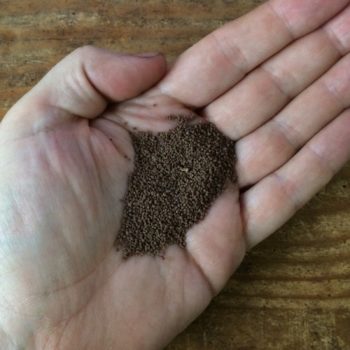
In row spacing of 18 inches (46 cm) works very well. Tighter spacing, 15 (38 cm) or even 12 inches (30 cm), produces the same number of tubers, but they are smaller. 48 inch (122 cm) row spacing will leave a comfortable walkway. 36 inches (91 cm) between rows will usually leave just a little walking space in between. 24 inches (61 cm) between rows will form a dense, unbroken canopy. With large varieties, even wider spacing may be beneficial; for example, New Zealand Red produced the greatest yields here on a 24 inch spacing. Wider spacing increases air circulation around the plants, which may help to prevent disease in warm, humid climates.
Growing from Tubers
Tubers are typically planted whole. You can cut tubers for more plants, much as you would seed potatoes. Make sure each piece has at least two eyes. It is best if the seed pieces are at least 1/2 ounce (14 g). If you cut tubers, let them heal for a few days in a humid environment before planting.
You can also pull sprouts from tubers and plant the individual sprouts. They root easily and this is a good way to spread your risk if you only have a few tubers of a particular variety. That said, I rarely see top yields from plants that are started this way. Our practice is to replant the largest tubers, which grow a large number of stems and almost always produce higher yields.
Plant whole tubers and seed pieces about two to three inches (5 to 7.5 cm) deep (shallower for smaller pieces and deeper for larger). Orientation of the tuber doesn’t appear to matter. I usually plant them horizontally, which is how most are found at harvest.
Growing from Seeds
Unless you are direct sowing your seeds, which I don’t recommend, you have a great deal of flexibility when it comes to starting your seeds. The obvious strategy is to start your seeds in winter or spring, about 10 weeks before your last frost. This will give you seedlings up to three inches (7.5 cm) tall that you can transplant outdoors. While I had some moderate success with this strategy, it is no longer our preference, because oca, like many plants that have not been selected for uniform germination from seed, is difficult to time properly. Oca germinates over a long period, which means that you will either have to transplant out over a long period or take your chances transplanting seedlings in a variety of growth stages all at once. If you have just a few, it probably doesn’t matter. If you have hundreds of seedlings, the logistics can be difficult.
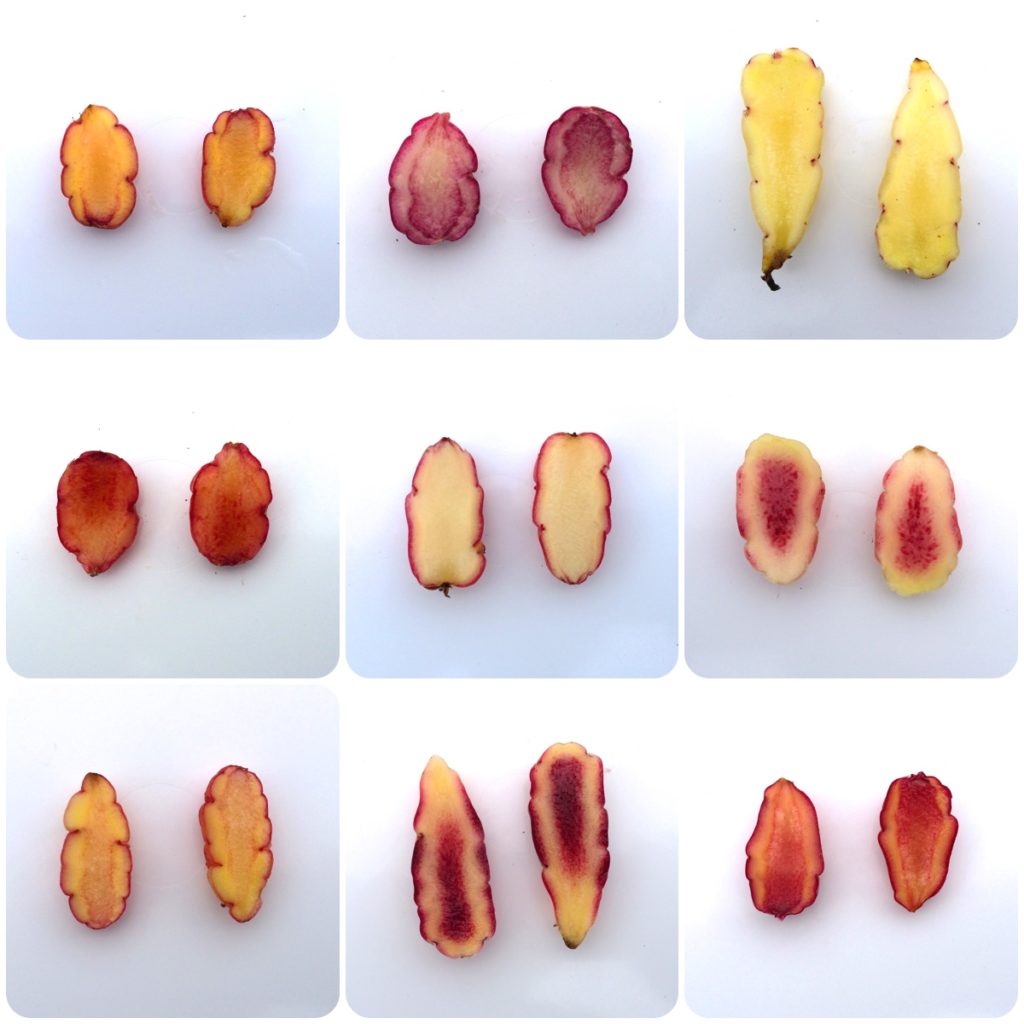
Because of that, I prefer to start seeds in early summer, transplanting to 1 gallon (4 l) pots and then moving the pots outdoors to form tubers and die back naturally in the fall. This produces mini-tubers which store just as well as large tubers and can be planted out directly in the spring. This not only serves as an easy propagation step (because you will usually get more than one tuber) but gives you a more robust tuber grown plant with a much more predictable sprouting period.
Oca has been propagated from tubers for a very long time and it is likely that this has resulted in impaired sexual reproduction. Seed is difficult to obtain in many climates and seed collected from heirloom varieties has a rather low germination rate. It also has very irregular germination, a common characteristic among plants that have not been cultivated for growth from seed. Expect a maximum germination rate of about 60%, but often much less.
You can direct sow oca seed, but unless you are producing your own seed, that is probably much too expensive a proposition to consider. The soil temperature needs to reach 50° (10 C) before oca even thinks about germinating, but you need to sow pretty thickly to get much at that temperature. The seeds will germinate rather late and may not size up in time to produce tubers. It can work though. It happens naturally here as well, because I don’t catch all the seed; we have volunteers coming up all year, but most of them don’t have a chance to make tubers.
This has been my most successful method for starting oca seeds: Soak seeds in room temperature water for 24 hours. Don’t omit this step as it greatly improves germination. Surface sow on any potting soil mix. Keep in a well lit area (natural light is fine at this stage) and aim for an ambient temperature of 74° F (23 C). Keep the soil moist at all times. I spray the seeds with water in the morning and the evening every day. Under the recommended conditions, on average, I see the first seedlings emerge at 12 days and the peak is reached in 16 days. Prick out seedlings and transfer to a different container to grow. The seedlings don’t survive as well in soil that is wet and warm enough to germinate the seeds. I transplant the seedlings to individual cells, water them in well, and then allow the soil to dry before watering again. You may continue to see new sprouts for several months. Keep the seedlings under strong light for at least 14 hours per day. A shorter photoperiod can result in the seedlings forming tubers, which will slow or end their growth. Grow indoors until the plants are at least two inches (5 cm) tall and then transplant to their final location.
I have found acceptable germination without any seed treatment, but treatment with gibberellic acid may significantly improve germination. Muñoz (1991) tested 24 hour applications of GA3 at 0, 500, 1000, and 1500 ppm concentrations and found the greatest benefit at 1500 ppm, with 80% germination on soil vs 20% for untreated seed. I have not seen such a large difference in my own tests with fresh seed, although GA3 did boost germination in three year old seed from 32% to 54% in one test.
Management
Many growers recommend hilling oca as it grows, much as you would for potatoes. When I hill oca, I harvest more tubers, but they are smaller on average. This may be a useful strategy for propagating the plant, but it is not ideal for producing tubers of good eating size. If you think it through, this makes sense. When you hill up the plants, you cause the formation of additional tubers into which the plant must divert energy, where previously all of the energy was sent into the tubers surrounding the root ball. In addition, you are burying parts of the plant that are photosynthesizing at a time of the year when oca needs to form tubers as fast as possible before the frost. So, you are reducing the amount of energy received by the plant and dividing that reduced amount of energy into a larger number of tubers. Because of this, I don’t recommend hilling oca when the main purpose is growing a food crop.
Growing under mulch has been recommended as a good strategy for protecting oca in warmer climates (Rowan 2015). This makes good sense, since mulching cools the soil and retains water, both of which are important for healthy oca plants. While mulching may delay sprouting in the spring, oca does most of its growing in the autumn, so late emergence is probably not a problem.
Companion Planting
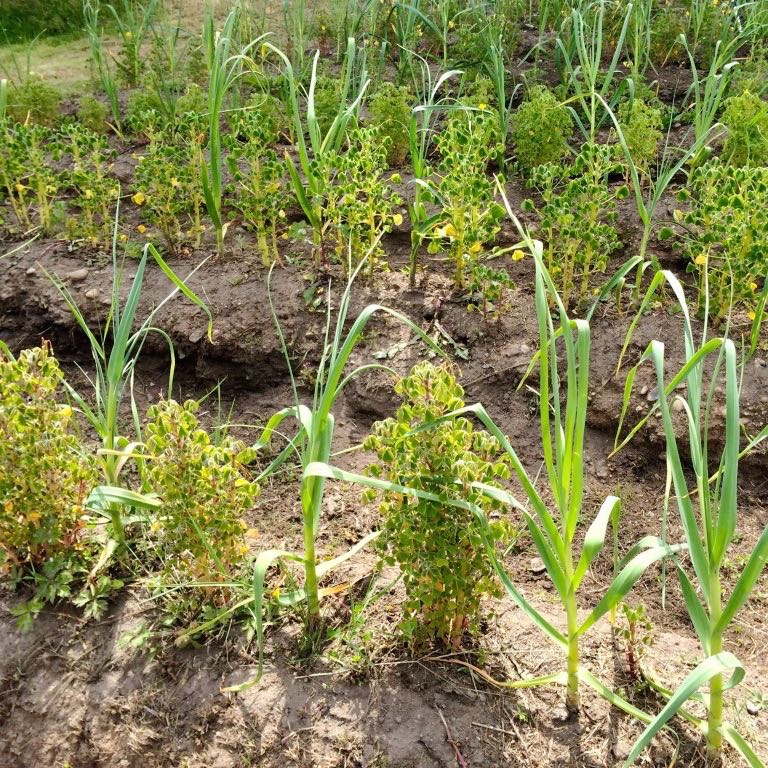
Oca is well suited for companion planting. It occupies garden space for a long period of time, but typically grows slowly through the spring and summer, leaving gaps that can be occupied by other plants. It is unappealing to most garden pests, which may afford some protection to other plants interspersed among the oca. It is tolerant of drought but equally happy to be provided a lot of water. These traits give a lot of flexibility for companion planting.
I typically interplant oca with garlic and onions. These companion crops are a good match, because garlic and onions are harvested before oca begins its fall growth spurt. After the alliums are removed, the oca plants will quickly fill the gap. This works well on our standard 15 inch (38 cm) spacing between oca plants, with garlic or onion alternating on the 7.5 inch (19 cm) centers. I have also successfully cropped peas and broad beans with oca, although this creates a little more cleanup work. In hot climates where the oca will benefit from more shade, it can be planted under corn, which will usually be harvested early enough that the oca can get a good measure of sun in the fall. There are probably many other crops that will work well as companions for oca. If you find a particularly good match, please let me know.
Growing as a Perennial
Oca is a perennial by virtue of its tubers, which survive winter dormancy to produce new plants in the spring. The aerial plant will not survive for more than one year in any climate; where not killed by frost, it will eventually senesce. This situation is similar to the potato and other Andean tubers like mashua and ulluco.
Growing oca as a perennial is not ideal for producing large yields. All of the tubers will sprout in subsequent years, crowding the plot and producing smaller tubers with each generation. It may be possible to grow oca for two or three years by spacing it widely and allowing the plants to fill the empty areas, but it is hard to imagine the benefit. Oca tubers don’t last for more than one year, so this is not a way to build up a store of tubers.
Oca plants are killed by frost, but the tubers will overwinter as long as they are not frozen. I recommend digging at least some oca to store indoors, rather than relying on it to survive the winter. An unusually hard freeze may kill the tubers and rodents can also cause serious problems during the winter in climates that are warm enough for oca to survive.
The nearest thing to growing oca as a perennial may be the “sloppy harvest” method, where only the large tubers are taken and small tubers are left behind to grow again. This certainly works for some people, but it risks the problem of unintentionally selecting for small tuber size.
Container Growing
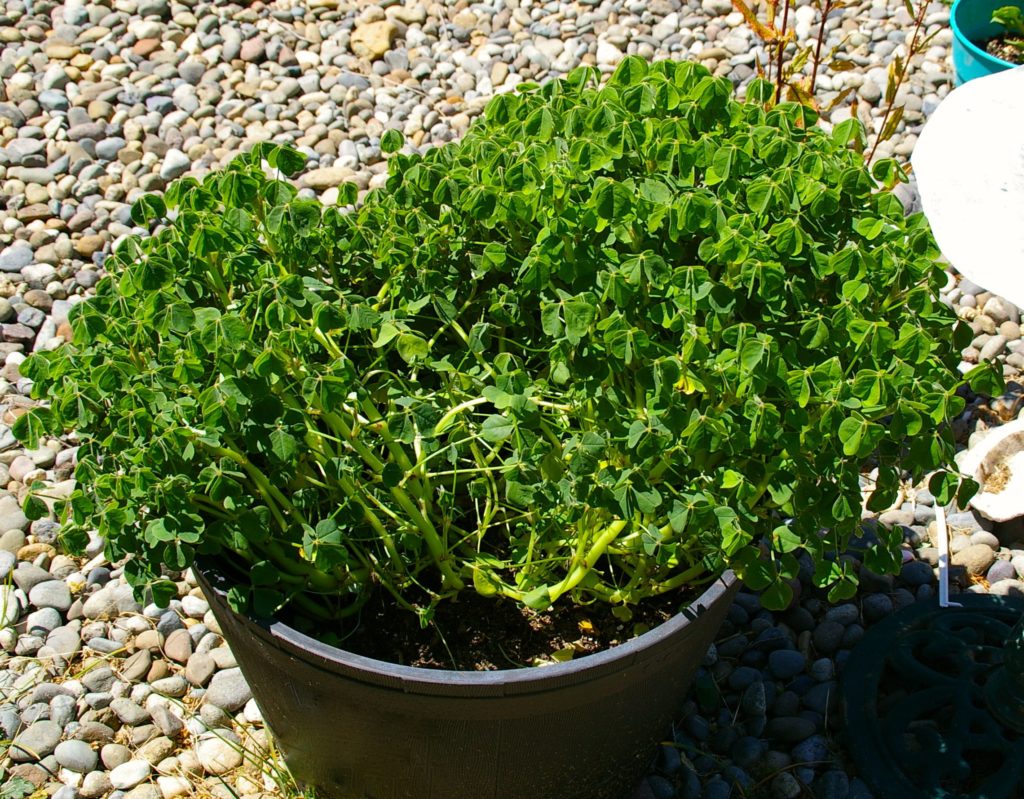
Oca grows very well in half barrel or larger containers. Smaller containers reduce yield significantly. I highly recommend drip watering for oca in containers because it is hard to achieve even levels of soil moisture with irregular watering. In climates with hot summers, you may have a hard time keeping the soil cool enough in containers.
Harvest
In North America, you should not plan to harvest oca any sooner than the first week of November. This is the earliest harvest that is likely to provide a worthwhile result. You might achieve 50% of the possible yield. If you can wait until the third week of November, you will be closer to 80% of the possible yield. 100% comes about in December or January in climates that are frost free and warm enough for the plants to do more than just survive. We usually schedule our oca harvest between Thanksgiving and the first week of December.
There is a matter of vigorous debate among oca growers surrounding the positioning of harvest relative to frost. One common claim is that best yields are achieved two weeks or more after the plants have been killed by frost. The tubers are presumed to continue to draw down nutrients from the dying plant for a last burst of growth. This may be true in some cases, but I haven’t found that it makes much of a difference. The weather pattern may play a role; I can imagine that a frost followed by a warm period might allow the tubers to keep growing. Here, when frost finally kills the plants, it often stays cold for a while and it is hard to imagine the nutrients being very mobile at low temperatures. I doubt that most people will see much difference between digging plants immediately after a frost or delaying a few weeks.
I have found that yields don’t increase much after the first of December, so I see little reason to wait on a frost if it hasn’t occurred by then. Similarly, if the first frost hits between the middle and end of November, waiting doesn’t seem to make enough of a difference to bother. If we get an unusual early November frost, then I would consider giving the plants some time to draw down what they can, since the harvest would be poor regardless.
Oca may suffer from precocious sprouting when near freezing soil temperatures are followed by significant and rapid warming. As far as I know, this has not been studied, but several growers have observed this and I have seen it here on occasion. When stored at low temperatures, these sprouted tubers still keep reasonably well.
Storage
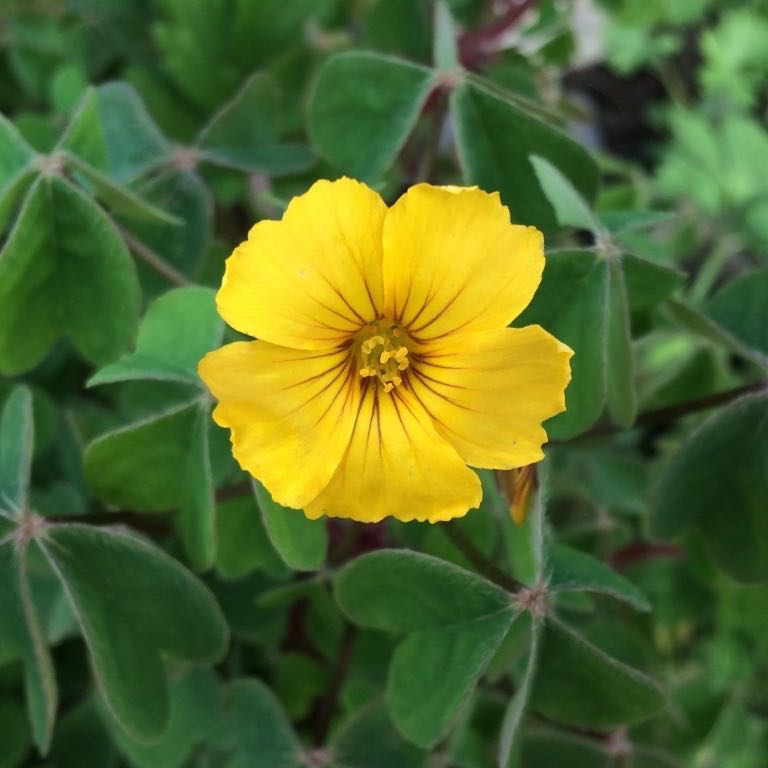
Oca is stored much like potato. Relatively low temperature and high humidity will produce the longest and highest quality storage. 40° F (4 C) with 90%+ humidity appears to produce a storage life in excess of a year for varieties with longer dormancy periods. Oca does not green like potatoes do, so exposure to light is not a significant problem, although light may degrade some of the nutrient content over time.
Oca also stores well at higher temperatures and will generally keep until spring at 70° F (20 C) without any problem, although the appearance and food quality of the tubers may degrade significantly. In one study, oca stored for 5 months at 39° F (4 C) and 70° F (20 C) lost 10% and 50% of its weight, respectively (Kays 1979).
Oca will lose acidity in storage and can be expected to reach its lowest acidity after 4 to 6 weeks at 70° F (20 C).
Preservation
Oca can be canned using instructions for processing potato. My results have not been particularly appealing, as the texture of canned oca is fairly mushy. Color is also lost in the canning process, which eliminates much of oca’s charm.
Oca can be sliced thin and dried. Dried oca does retain its color and can be used in soups or stews.
Traditionally, oca is made into a product known as chuño, which employs a low tech freeze drying procedure, wherein the tubers are allowed to freeze outdoors at night and then are dried in the sun during the day for about a week (Hodge 1951). It is highly unlikely that this procedure would work at temperate latitudes. It may be possible to make chuño using a freezer and a food dehydrator. I have tried this, but the results weren’t very good. Or, perhaps they were; having never tasted traditionally prepared chuño, it is hard to be certain.
Propagation
Vegetative Propagation

Oca is traditionally propagated by replanting tubers. Because oca is a naturally hybrid crop, vegetative propagation is the only way to maintain varieties. I recommend saving the largest tubers for replanting. While tiny tubers will get you started, larger tubers generally produce bigger plants faster, with more stems and earlier flowering (although flowering only matters if you want to produce seed).
In the Andes, oca varieties that appear to be uniform often have considerable genetic diversity and may actually represent multiple genotypes grown from seed with similar characteristics (Pissard 2008) or, more likely, the accumulation of mutations from generation to generation. Replant your best to ensure that you don’t encourage deleterious mutations.
Oca is also easy to propagate from stem and stolon cuttings, and from slips. Oca stem and stolon cuttings can be easily rooted in water or damp soil as long as they are taken before the plant begins to form tubers. Slips are produced by rooting tubers in shallow soil. As soon as the main sprout begins to form, remove it. This will awaken additional buds on the tuber. Typically, by the time the sprouts are about 2 inches (5 cm) tall, they will have formed sufficient roots to detach the slip and plant immediately.
Sexual Propagation
Oca is an allopolyploid, usually of octoploid configuration, but occasionally tetraploid; it is a hybrid containing the genomes of two parent species. Its polyploid nature makes it a naturally heterozygous plant. Because of this, oca does not grow true from seed. Oca seed is used primarily to breed new varieties which are then vegetatively propagated. As is usually the case in plant breeding, most of the progeny won’t be as good as the parents, but your odds of finding a good one aren’t too bad.
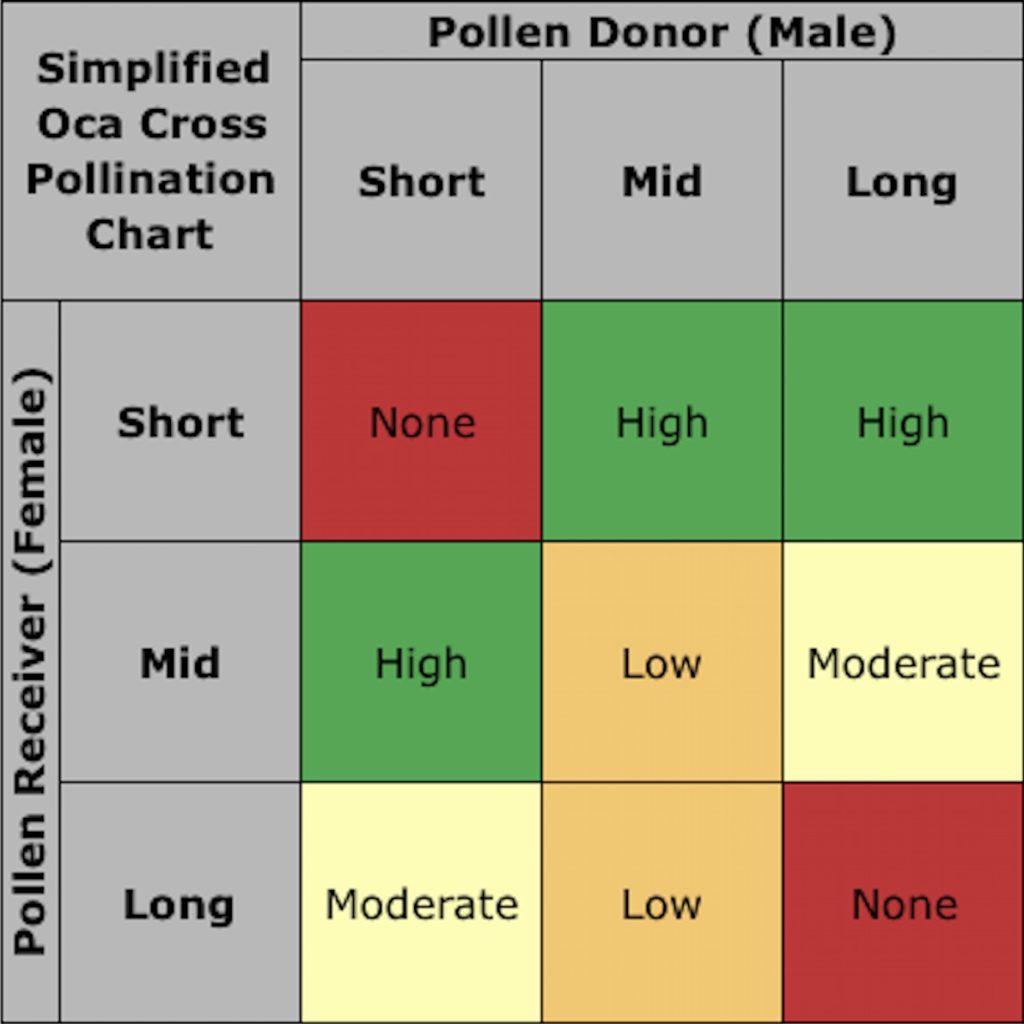 Oca flowers have a tri-stylous incompatibility system, a common feature of Oxalis. Flowers have three tiers of sexual parts: two tiers of stamens and one of styles. In order to obtain seed, a style must be fertilized by pollen from the corresponding tier of a different flower type. For example, a short styled flower may be pollinated successfully by the short stamens of a mid styled flower or a long styled flower. Once you understand how this system works, you can plan crosses with better efficiency.
Oca flowers have a tri-stylous incompatibility system, a common feature of Oxalis. Flowers have three tiers of sexual parts: two tiers of stamens and one of styles. In order to obtain seed, a style must be fertilized by pollen from the corresponding tier of a different flower type. For example, a short styled flower may be pollinated successfully by the short stamens of a mid styled flower or a long styled flower. Once you understand how this system works, you can plan crosses with better efficiency.
All crosses exhibit different degrees of incompatibility, which results in different levels of seed set (Trognitz 2000). It is possible to make careful hand crosses between specific levels, but most growers who bother with hand pollination will probably simply brush the flowers without regard to collecting pollen from specific tiers. The level of seed set that can be achieved by these kinds of simplified hand crosses is indicated in the crossing chart.
The chart reveals what was, until recently, a common problem for the aspiring oca breeder: anyone growing only short styled or only long styled varieties would not be able to produce seed and someone growing only middle styled varieties would need to grow enough plants to obtain the small amount of seed produced.
Of course, there are additional levels of complexity. Some varieties flower more readily than others. Flowering can take place over a period of about five months and most varieties will not flower for the whole period; in fact, most flower for less than a month. In order to produce seed, it is important to have a range of varieties with different flower types, flowering onsets, and flowering durations.
Although oca flowers primarily in autumn at temperate latitudes, it does not require short days for flowering. It does require cool, humid weather, which primarily occurs in fall in most climates. Here at the Washington coast, where weather is cool and humid year round, oca planted in March begins flowering about the end of May and continues until the frost. We see the most abundant flowering when the daily temperature range is between 44 and 62° F (7 to 17 C) with humidity of 88% or more. In warm, dry climates, most oca varieties will generally not flower at all.
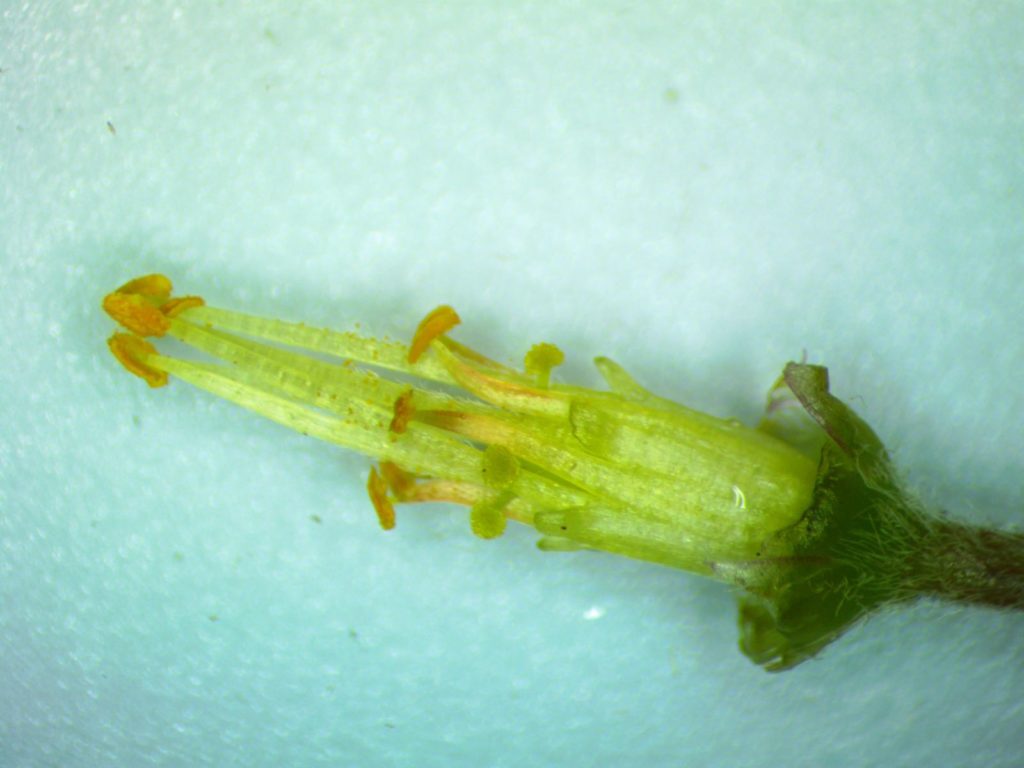
If you have the right climate and the right selection of compatible varieties, oca can produce quite a lot of seed. I can easily collect 300 seeds per plant from varieties that flower abundantly and for a long duration. Each pod can typically contain 15 seeds, in five sets of three. Where the proper mix of varieties is present, oca can produce seed without human intervention and potentially naturalize. Seed set has been observed in the field in the Andes and farmers may intentionally or unintentionally propagate varieties that have appeared as volunteers (Bonnave 2014).
Collecting oca seed can be a challenge since the pods expel the seeds when mature. You can bag the pods, but the fragile pedicels tend to break if there is any wind. You can also collect entire inflorescences and keep them in water until the pods mature. This works fairly well if you don’t pick them too early, but the quality of the seed tends to be low. They germinate and store poorly. I have put seeds from early harvested pods under the microscope and observed that they have minimal endosperm. As a result, I have settled on daily collection of only those pods that are fully mature. Mature pods change orientation and point toward the sky and that is the time to harvest them. Even with daily collection, you will lose some seeds this way, but what you do collect will be fully ripe and of high quality. Store the plucked pods in a humid environment like a plastic bag for a few days so that they can finish expelling their seeds.
Crosses between oca and other Oxalis species, many of which are sold as ornamentals, are unlikely but not impossible. The genus Oxalis is complex, with plants covering a range of different chromosome numbers, levels of ploidy, and pollen incompatibility systems. It is very unlikely that any Oxalis species that is not of South American origin could hybridize with oca. There may be a few Andean species that have some potential for crossing. There is a group of Oxalis species named the Oxalis Tuberosa Alliance that are evolutionarily close and may be able to interbreed in some cases. See Emshwiller (2002) for more information.
I see a lot of pollinator interest in oca here. Bumble bees, hover flies, and small native bees, particularly a Panurginus species, are all very active. Honey bees are occasionally interested when native flowers are in dearth. The more oca that we have grown, the more pollinator activity I have observed.
When fully dried, there are approximately 2900 oca seeds per gram in seed collected from mixed varieties. Varieties differ in seed weight by about +/- 26%.
Pests, Diseases, and Defects
Pests
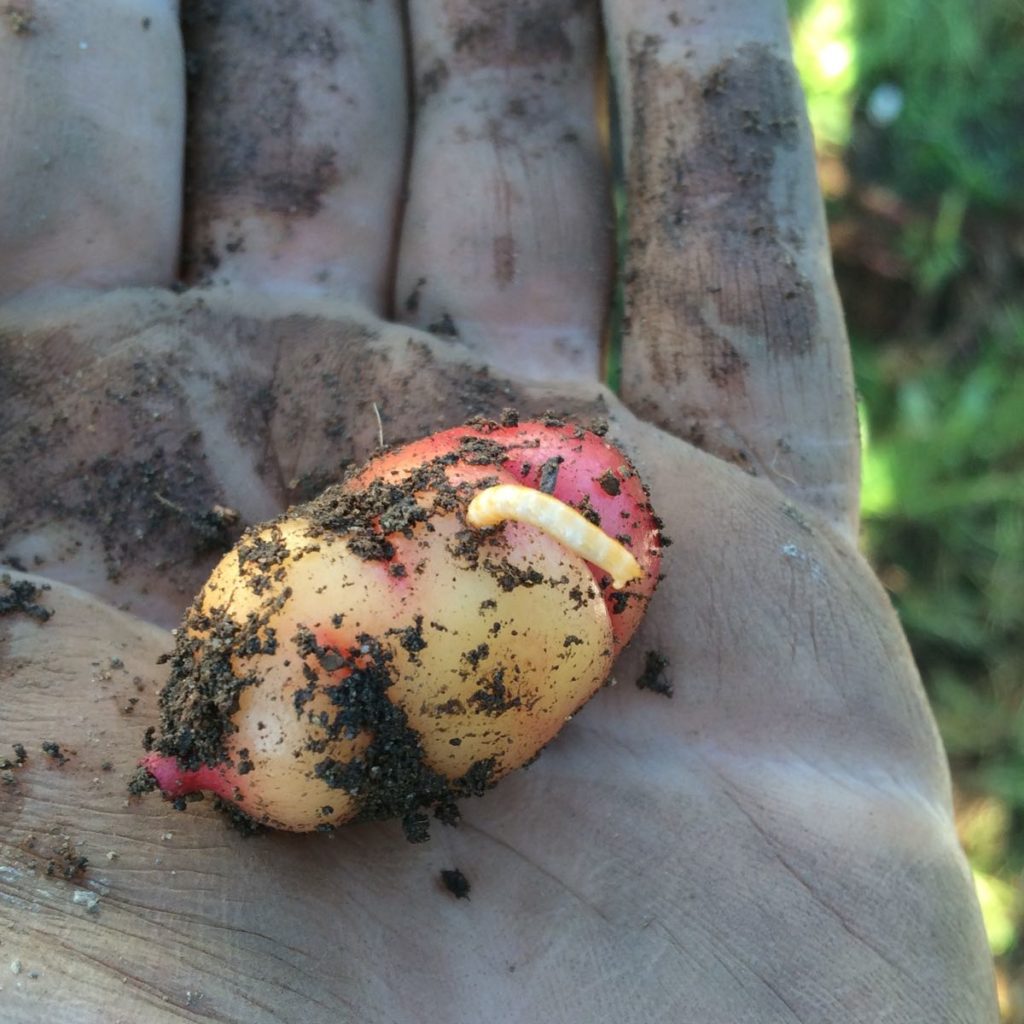
Oca seems to have few significant pests in North America other than the vole (field mouse). Voles have a great love for oca tubers and can do significant damage to the crop. Because oca is harvested fairly late in the year, it is often the only food source present in large quantities. This can attract large numbers of voles. Deer will usually only lightly browse oca, but occasionally they seem to develop a taste for it and can become a serious problem.
Tarnished plant bugs can occasionally become a problem, particularly for breeders, because they seem to be mostly interested in the flowers. Wireworms can cause cosmetic damage to tubers, but are rarely a serious problem.
Oca is often named as a possible host of the potato cyst nematode. The potato cyst nematodes are a pair of species in the genus Globodera that live among the roots of mostly solanaceous plants, on which they feed, reducing yields and potentially allowing diseases to gain a foothold. They are common in the Andes and a few varieties are widespread in Europe, but they are rare elsewhere in the world due to agricultural inspection and quarantine. Potato cyst nematodes have popped up in a couple places in North America (Idaho and Quebec) where extreme measures have been taken to stamp them out.
An evaluation of 303 accessions of oca for their potential as a trap crop for PCN found that oca will stimulate egg hatch of PCN, but then fail to sustain them, dramatically reducing the dormant population (Franco 1999). This may reveal the wisdom of rotating between potato and oca in traditional agriculture in the Andes. (Similar results were found with ulluco and mashua as well.) The evidence seems pretty clear that oca is not a host plant for potato cyst nematodes and, to the contrary, may actually be useful in combating the spread of PCN. The USDA has removed oca from the list of possible PCN host plants (Sullivan 2007).
Diseases
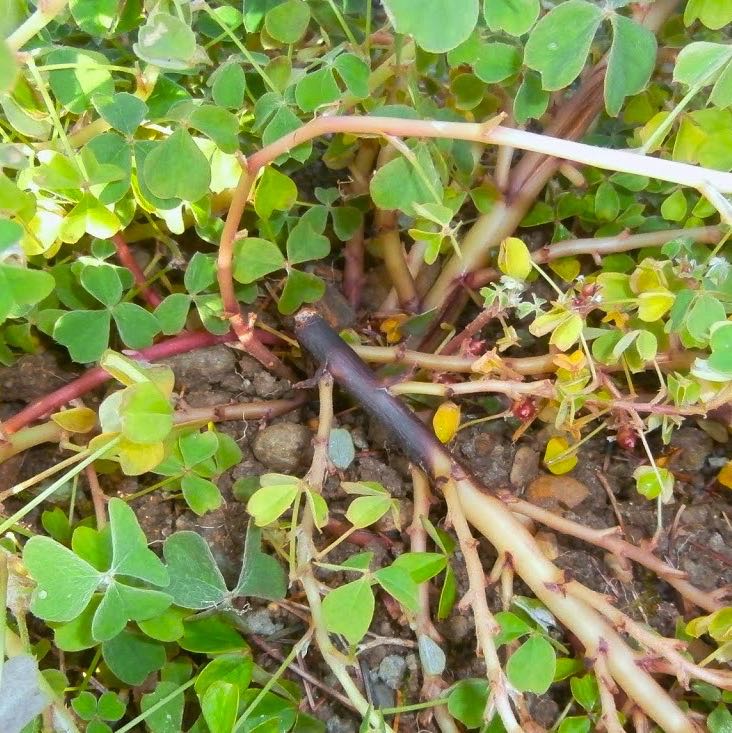
In its native range in the Andes, oca is vulnerable to many diseases. Most of the diseases are viral and their primary symptom is a reduction in yield. While many of the most widely available varieties of oca in North America have arrived through government quarantine and so should be substantially free of disease, there is no question that many others have arrived without undergoing any examination or treatment and carry viruses endemic to the Andes. These viruses are not easy for the grower to detect and very difficult to identify specifically. This is both good and bad; it is good because the effect of the viruses is mild enough that plants still yield reasonably well if they are not infected by too many, but it is bad because it is hard for the grower to determine which plants are affected in order to isolate them from the rest of the crop.
Oca Decline
Oca decline is a term that I use to describe what appears to be a complex of linked symptoms caused by an unknown disease. I previously called this “Early Sprouting Syndrome,” but as I have continued to watch and learn, I have come to associate four different symptoms. Over a period of years, oca varieties tend to increasingly show the KERF complex: knobbly tubers, early sprouting in some of the tubers, reduced yield, and fasciation (in both stems and tubers). Each of these symptoms is likely to have multiple causes, but when they appear together, repeatedly, and many plants are affected, I would judge it to be oca decline. This problem can be eliminated through meristem culture and it can be reintroduced through contact with plants showing the symptoms. That is pretty solid evidence of a disease as the cause. It is probably not a virus because a number of varieties that experience the symptoms have been fully indexed for viruses. It might be a phytoplasma, a type of bacteria without a cell wall that is difficult to diagnose because they cannot be cultured. Meristem culture on antibiotic medium appears to produce symptom free stock more easily, which is another piece of evidence for a bacterial cause. Oca decline is seen almost everywhere that oca is grown, with the possible exception of New Zealand. It is common in the Andes, the USA, and Europe. It might be one disease or more than one and the symptoms may be caused by different organisms in different regions. As of this writing in 2021, I am just starting to experiment with the elimination of this disease from our stock and I will almost certainly know a lot more in a few years. It appears to be possible to significantly reduce the number of symptomatic plants by using late season aerial tubers as planting stock. I have seen no indication that this condition spreads through true seed, so that is a good way to avoid exposure.
Bacteria and Fungi
The worst common disease of oca in North America appears to be a stem rot. The lower portion of the oca stem goes soft and black and the stem often falls off. This may affect only a few stems or the entire plant. It appears that the disease is most severe in warm climates, where it may actually infect the tubers and degrade them in storage. In cool climates, like ours, plants typically survive the infection and I haven’t observed any problems with tubers in storage, although I reserve plants that have been infected for eating and do not replant the tubers.
Oca tubers are vulnerable to a bacterial soft rot, which begins as small spots on the surface of the tuber and enlarges to cause severe damage to the tuber. The species of bacteria is currently unknown, but it wouldn’t be surprising if it is one of the same species that causes soft rot in potato. This condition may be related to the stem rots described above. Any tubers showing sunken black spots should be discarded, as these tubers will carry the disease to the next generation and potentially infect other tubers in storage.
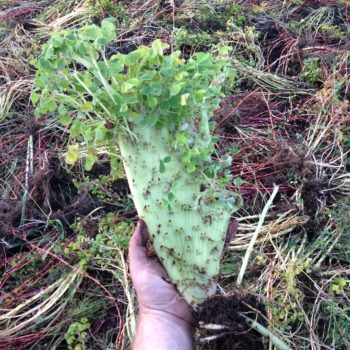
The primary storage protein in oca tubers, recently characterized and named ocatin, has antibacterial and antifungal properties (Flores 2002). This may help to explain some of oca’s resilience. Tubers are rarely damaged by disease to the extent that is seen in potatoes.
When establishing oca in tissue culture, there is almost always a halo effect, which is characteristic of bacteria streaming from the cut. This effect is often very strong. This appears to be an indication that oca is typically infected by bacteria, perhaps pathogenic, endophytic (symbiotic), or both.
Viruses
Recognized viruses of oca include Arracacha virus B, Papaya mosaic virus, Potato black ringspot virus, Potato virus T (FAO 2007), and Ulluco mild mosaic virus (Fletcher 2001). Some varieties of oca may be resistant to Potato virus T (Lizarraga 2000). None of these viruses are likely to occur in varieties that arrived in North America through agricultural quarantine. Because the viruses that they share in common are not present in North America, potato and oca probably do not require isolation or rotation between crops. Although relatively few viruses have been identified in oca, the majority belong to families that are often seed transmitted. You should not assume that seed grown progeny of potentially infected varieties are free of disease.
I have detected relatively few viruses in heirloom ocas in the USA. The most common are Papaya Mosaic Virus and an unidentified potyvirus (I have not been able to identify it at any rate, but I have only run it through tests for common potyviruses). I think a likely guess would be Ulluco Mosaic Virus. Both are rare enough that it was easier to abandon the infected varieties than to attempt cleanup. I have also once detected Cucumber Mosaic Virus in oca. I still see occasional mild symptoms in oca that make me wonder if there might not be other viruses lurking, but mild virus symptoms are easy to mistake. I can’t afford to test for everything, so I will wait on the science to sort that out.
| Virus | Genus | Present in USA | Frequency in Oca (USA) | Seed Transmitted |
|---|---|---|---|---|
| Arracacha Virus A (AVA) | Nepovirus | No | Unknown/Not Detected | Possibly in oca |
| Arracacha Virus B (AVB) | Cheravirus | Maybe | Unknown/Not Detected | Possibly in oca |
| Cucumber Mosaic Virus (CMV) | Cucumovirus | Yes | Rare | Possibly in oca |
| Papaya Mosaic Virus (PapMV) | Potexvirus | Yes | Rare | Unlikely in oca |
| Potato Black Ringspot Virus (PBRSV) | Nepovirus | No | Unknown/Not Detected | Unlikely in oca |
| Potato Virus S (PVS) | Carlavirus | Yes | Rare | Unlikely in oca |
| Potato Virus T (PVT) | Tepovirus | No | Unknown/Not Detected | Possibly in oca |
| Ulluco Mild Mottle Virus (UMMV) | Tobamovirus | No | Unknown/Not Detected | Unknown |
| Ulluco Virus C (UVC) | Comovirus | Yes | Rare | Unlikely in oca |
| Unidentified potyvirus (not PVA or PVY) | Potyvirus | Yes | Rare | Unlikely in oca |
Arracacha Virus A (AVA, genus Nepovirus)
Probably not present in North America or at least very rare if so. This virus is reported to be uncommon in oca and is probably asymptomatic. Probably spread by plant to plant and mechanical contact and perhaps by nematodes. May be transmissible through true seed. No field tests. Not worth screening unless you know it is in your collection or possibly if you are growing arracacha of unknown origin.
Arracacha Virus B (AVB, genus Cheravirus)
This infects several of the Andean tuber crops, including oca. It is normally asymptomatic in oca, potato, and arracacha. The O strain (AVB-O) is fairly common in oca in the Andes. It spreads from pollen to seed without infecting the parent plant. This would obviously be bad for any oca breeding program. The virus is also transmissible by plant to plant contact. This virus was reportedly detetced in an heirloom oca variety in California in the early 2000s. There are no field tests available. There used to be ELISA reagents available for this virus, but they have been off the market for several years now. Unfortunately, I also don’t know of any labs that offer PCR testing for Cheraviruses, so there is really no option for testing, short of sequencing, which is very expensive. Ideally, you should screen for this if you grow heirloom ocas or arracachas, but you may not be able to find someone who can do the testing. AVB is a quarantine virus in the USA.
More info: DPVWeb, EPPO, Plantwise
Cucumber Mosaic Virus (CMV, genus Cucumovirus)
An extremely common, worldwide virus with the widest host range of any virus. It has not been formally reported in oca, but I have gotten a positive field test for it. The infected plant was showing mottle on the lower leaves. In potato, infection rarely reaches the tubers, so healthy plants can probably be recovered from the tubers of infected plants if oca is similar. Primarily insect transmitted, but also by plant to plant contact. Field tests are available. Not worth screening unless you know it is in your collection or perhaps only on acquisition.
More info: DPVWeb, EPPO, Plantwise
Papaya Mosaic Virus (PapMV, genus Potexvirus)
This virus occurs in the northern Andes and the USA. In the Andes, it frequently infects ulluco in the field. In the USA, it primarily infects papaya in the Southeast, but it also is (or was) present in some heirloom varieties of mashua, oca, and ulluco. In papayas, it causes the confusingly named “pawpaw disease,” which has nothing to do with North American pawpaw (Asimina triloba). In oca, it appears to be nearly symptomless, perhaps associated with a reduction in flowering. Probably spreads by plant to plant contact, as is usually the case for potexviruses. Field tests are available. This virus is common in heirloom ulluco varieties and I recommend routinely screening for it.
More info: DPVWeb, EPPO, Plantwise, Salazar (2006)
Potato Black Ringspot Virus (PBRSV, genus Nepovirus)
A widespread virus in South America, primarily infecting potato, but also oca. I am not aware of any positive tests in North America. Symptoms have not been reported for oca. Probably spreads by plant to plant contact. No field tests. ELISA tests for the closely related TRSV will also detect PBRSV, so I wouldn’t be surprised if the TRSV field tests (which are also immunological) can also detect it. Not worth screening unless you know it is in your collection. Also known as Andean Potato Calico Virus. PBRSV is a quarantine virus in the USA.
More info: DPVWeb (Pictures), EPPO (Pictures), Plantwise, Richards (2014)
Potato Virus S (PVS, genus Carlavirus)
PVS is a very common mosaic virus in potatoes. I have occasionally seen positive serological tests for PVS in oca. As far as I know, PVS has not previously been reported to infect oca. The infection was first detected with an Agdia Immunostrip and later confirmed by ELISA. Infected oca plants have not shown any symptoms that I could recognize. Primarily spread by aphids and plant to plant contact. Field tests are available. It doesn’t appear to spread to oca very easily, but if you are growing potatoes and oca, it couldn’t hurt to screen both. Test results have never been strong, so it is possible that this is not actually PVS, but another Carlavirus that cross-reacts, like Potato Virus M.
More info: DPVWeb, EPPO, Plantwise (Pictures)
Potato Virus T (PVT, genus Tepovirus)
PVT is native to the Andes, where it infects several of the Andean tuber crops, including oca. Symptoms in oca have not been reported. It is somewhat common in oca in the Andes and is known to spread through true seed and pollen. Transmission occurs from pollen to seed without infecting the parent plant. It can also be spread mechanically but is not known to be spread by insects. I have not seen a positive test for PVT from ulluco (or anything else) in the USA. No field test available. There is probably not a compelling reason to screen for PVT in the USA, but I test for it anyway, because viruses that spread through true seed make me nervous. PVT is a quarantine virus in the USA.
More info: DPVWeb, EPPO, Plantwise
Ulluco Mild Mottle Virus (UMMV, genus Tobamovirus)
This virus appears to occur primarily in Bolivia and Peru. It primarily infects ulluco, but may also infect oca. I have not seen a positive result for Tobamovirus in heirloom oca in the USA. Symptoms have not been described for oca. Transmission is probably primarily by plant to plant or mechanical contact. Field tests are not available. There is probably no need to screen for this virus in the USA. It appears that UMMV was initially described as a strain of Tobacco Mosaic Virus (TMV/U), but as far as I can tell, TMV does not infect oca.
More info: EPPO, Brunt (1982)
Ulluco Virus C (UVC, genus Comovirus)
A virus mostly restricted to South America but it may be present in some heirloom ulluco varieties and rarely in oca. No symptoms have been reported in oca. No specific vector is known and it is not aphid transmitted, but Comoviruses are typically spread mechanically and by beetles. It does not infect potato. No field tests are available. It may be possible to detect this virus with ELISA for Cowpea Mosaic Virus, although it would be more reliable to get PCR for Comoviruses. Probably not worth screening for in the USA.
Defects
Knobbly Tubers
Knobbly tubers are one of the most common problems with oca. Tubers may form smaller tubers at their eyes, often one or two, but sometimes all of them. The degree to which this is a problem is a matter of opinion. It doesn’t affect edibility, although it does make the tubers a little harder to clean and they can be harder to cook unless you remove all the daughter tubers first. There are probably a number of causes for this condition, but the most concerning is Oca Decline, described above in the Diseases section.
Fasciation
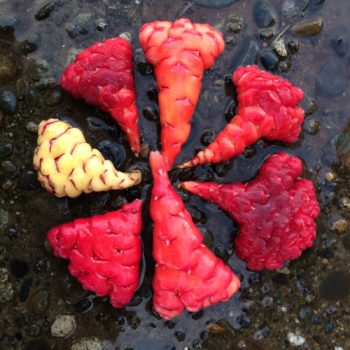
Oca is frequently affected by fasciation. This can be good or bad. Fasciation in the aerial plant tends to produce lower tuber yields. Fasciation in the tubers can result in significantly larger individual tubers, although yields are not much changed. I have observed that fasciation rarely occurs in plants freshly grown from clean tissue cultures, which may indicate that it is the result of a disease process.
Mutations
Oca is very prone to somatic mutations. If you grow enough plants, you will see tubers that partly or entirely change color. Where an eye is included in the mutated color region, you can grow a new plant from that sprout and it will maintain the new color scheme. We can easily see changes in color, but there are probably other mutations that we can’t easily detect. This is an important reason to always replant your best. If you select the best varieties with each generation, you may improve the variety. If you perform no selection, the quality of the variety may decline as undetected mutations accumulate.
Crop Development
Oca is somewhat limited as a crop in North America by a combination of factors: its short day requirement for forming tubers, its low tolerance for hot weather, and its lack of frost resistance. Breeding efforts that target these limitations should result in a crop that can perform better in continental climates.
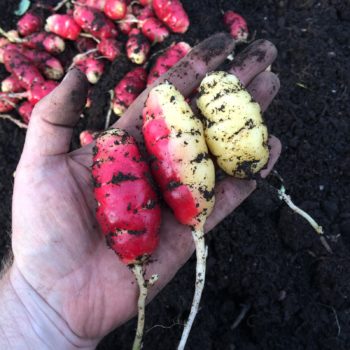
Eliminating oca’s short day requirement would result in a plant that would form tubers earlier in the year, which would have two significant effects: it would make it possible to grow oca in areas with early frosts and it would improve yields in areas with later frosts, by allowing oca tubers to continue growing for a crucial extra month or two. A completely day neutral oca could be grown through the winter in warm climates as potatoes are. Potatoes were bred into today’s day neutral varieties from stock that was originally short day adapted, so we know that such a change is possible, but we don’t know what the odds are. We might find an oca seedling that has become day neutral in a single generation, or we might have to take the slow route by breeding varieties that are a few days earlier, gaining additional days with each generation.
In North America, finding ocas that are more tolerant to hot weather may be nearly as important. Although oca can survive hot weather, it usually yields poorly if the cool weather recovery period before tuber formation is short. Oca’s genome includes contributions from plants that appear to have good drought tolerance. Early breeding results in Australia have shown some good adaptation to heat as well. Growing oca from seed in hot summer climates may result in fast improvements to these traits.
Another possible route to improved yield would be better frost resistance. Breeding frost resistance into plants that don’t already have some has proven to be difficult in most cases. However, some oca varieties might carry a degree of frost resistance, owing to their high Andean origin. Ocas that could survive light frosts might have a month or more of additional time to bulk tubers, which could make a significant difference in yield.
It might be possible to breed oca varieties that reliably exhibit fasciation in the tubers. Some varieties of oca develop fasciation much more frequently than others and if this trait could be fixed, it would generally increase tuber size, if not yield. Fasciated tubers often produce fasciated stems (Hus 1906), but fasciated stems do not reliably produce fasciated tubers. It is possible that fasciation is a symptom of disease, which would make it a dead end.
Relatives
Oxalis tetraphylla
Oxalis tetraphylla (previously O. deppei) is a common ornamental plant that also has good potential as an edible. It often goes under the name Iron Cross Plant, which is actually the name of one cultivar. It is native to Mexico. It is normally propagated from divisions because it requires a combination of varieties with different stylar arrangements to set seed, similar to oca. The bulbs can grow several inches long and they are crisp and usually pleasant tasting; either neutral like a water chestnut or tart, similar to oca. I think this plant has good potential as a food crop with a little work.
Learn More
There aren’t many good sources of information about oca on the web. Here are some of the best that I have found:
- Download a free PDF of Lost Crops of the Incas. It is a great introduction to Andean crops, although somewhat out of date.
- Check out Crap Crops of the Incas on Radix, a classic!
- Oca Genetics, also on Radix.
- Guild of Oca Breeders Cultivation FAQ
- The Growing Oca blog, which sadly doesn’t seem to be getting updated anymore.
- Oca Morphological Descriptors (in Spanish)


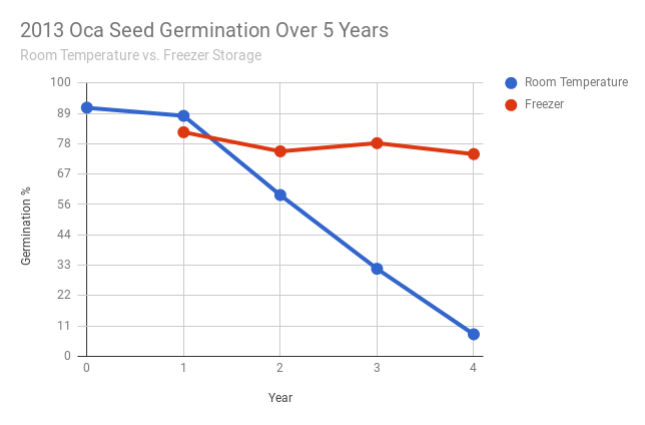
If the tubers grow near the surface and turn green are they still ok to eat? I know if that happens w potatoes that part is toxic.
Yes, they are still safe to eat. Potatoes are pretty unique in the way that they accumulate toxic glycoalkaloids. None of the other tuber crops that we grow become toxic when exposed to sunlight.
Thanks for the info it is great, it took a while to find until I learned they are not really called Yams. I have just harvested my first crop in the Marlborough Sounds NZ which I put in tubs. The white ones had a bit of green on them so was wondering if they were safe to eat. Now I know. They have got to be my favorite crop I have grown in the garden, Yum and easy to cook.
Brilliant thank you, I have just started harvesting mine in NZ and one plant is a pale cream with green on one end of many of the tubers so was wondering if they were safe. Thank you I’ll throw them in with my roast.
My oca has had a a lot of black bean aphid infestation. I’ve cut the tips and sprayed with neem and horticultural soap however they have started coming back in noticeable numbers. Plants (in a tub) are looking very sad, possibly from the hot summer. Can I cut it back to get rid of aphids and for new growth or do you think that’s a bad idea?
It is usually safe to cut oca back, but I’m not sure if it is a good idea under high stress conditions.
Thank you, I’ll make judgement. I figure there’s lots more growing season left and they should resprout. However they do look rather sad atm.
Wonderful information! Thank you!
I’ve just noticed that where I planted (and harvested) my oca there are no weeds. The rest of my allotment (shared garden plot) is covered in them, but the oca section is barren! It’s early spring, and I’d expect to see something trying to grow. This happened to my other friend here in the UK in her garden too. Any ideas why? Can we rotate other crops into that space safely or will they fail to thrive?
I haven’t noticed that I have to do less weeding where we grow oca, but it is possible that there is some effect. Other Oxalis species have been evaluated and found to be somewhat allelopathic. It may also have something to do with the fact that you had to dig up the oca. There is more soil disturbance when harvesting root crops, which bury or turn under weed seeds.
Just wanted to say how much I appreciate this excellent article. Harvested my first ocas today, came looking for advice on storage or whether we have to eat what we can and give the rest away, so many thanks!
My late grandfather told me once that he knew them as ‘Peruvian potatoes’ in the 1920s in NZ. He would have been in his teens then as he was born 1911. I took a few tubers from his farm in the early 1970s when I was a child and I remember them growing in odd corners around our farmhouse. I don’t remember them being grown specifically in the vegetable garden, but maybe they were as we used to get a few feeds of them.
Summers were cool and wet (annual rainfall was 2000mm), soil was fertile and slightly acid so conditions probably suited them.
i grew up in the south island of NZ in the 1970s and we always had yams in the winter with sunday roasts, this is my first year growing them and now i live in Wanganui in the North island, i planted two tubs maybe in mid November and then the laat tub at Christmas, im babying that last tub now the temperature is dropping to near freezing at night, and just waiting for the tops to die down in the other two tubs where i can already see one good sized yam poking through the soil…. waiting waiting ….yum yum can’t wait
Hello! Thanks for this excellent article. We live in the mountains in southern Mexico and acquired a handful of oca from Ecuador. It’s now growing in a container but we’ll take your advice and plant the seedlings out to give them more space to (hopefully) make bigger tubers. Our drawback is very clayey soil and lots of shade. Our advantage is that winters are cold, dry and sunny (after the rainy summer) so we might be able to hit the oca jackpot of short days, sun, and no frost.
Good luck. Oca has been grown in the mountains of Mexico for a few hundred years, so it is definitely possible.
Thought I’d publish our oca followup here. The oca grew in a pretty small plastic container in a shaded area. At 2200 m altitude on a north-facing slope. It kept raining through July to October, at times torrentially. The oca survived all this and the stalks grew pretty well. October to now was cold but dry. We left them in peace and the leaves started wilting in January. We harvested last week and got two handfuls of tubers, half the size of a small marble and the other half the size of the tip of a man’s thumb. Haven’t cooked the feast yet so don’t know about flavour! We’ll replant the slightly bigger ones.
Can you grow oca around the Fraser coastal area of Queensland Australia. If not where and what time of the year can you get and buy them please
I don’t have open ground but can dedicate one container. From research the tuber seed is planted no deeper than 10cm and do not hill/mound if you want new tubers to be large size. There is no info whether new tubers form below, above or alongside tuber seed. I need your expertise on container depth. If below, I have deep containers for 28cm or 35cm soil below tuber seed (A) 43cm diameter x 38cm depth or (B) 45cm diameter x 45cm depth. If above or alongside, I have (C) 45cm diameter x 20cm depth for 20cm soil below tuber seed. Thanks in advance.
Hi Jacqui,
From my experience the tubers are not much deeper than 20 cm deep. The tops of the tubers are often just above the ground . If you would like to try it, I would advise two pots. One don’t mound and try mounding about 100mm more dirt on the other mid summer when the flowers appear. Maybe it is the cooler summers we have in New Zealand but that extra mounding doubles or triples our yield with no impact on tuber size.
hi grown yams for the first time this year in England First few i dug up were pink tinged as i remember as a child in NZ, but all the rest are just white – are they safe to eat for my christmas day lunch – fingers crossed!!!!
There are no conditions where they become unsafe to eat (as with potatoes, for example) so you should be fine. Color develops with maturity, so tubers tend to lack color when they are small or harvested early. And some varieties are just white, of course. Enjoy!
I’ve grown Oca in sth U.K. in Root-Nurse bags in light compost, and the results were good, but some tubers have crater-holes. I can’t decide if this is slug damage, or wire-worm. I did find one leather-jacket larvae in a bag. Anyone had craters in their tubers – & know a fix?
I guess nematodes will be required next year. The worst pest in U.K. veg garden however is the urban fox.
I’m just harvesting my first crop in North Wales, and I’m horrified to find lots of tiny dark craters – did you grow any more – do you know now what caused yours?
If you can post a picture at our forum or the Facebook group, we might be able to figure out what caused the problem.
Very detailed and good infomation for me ,thanks.
I wonder if I could grow Oca and some of the other photosensitive long season crops here in the SW suburbs of Toronto.
Due in part to proximity to Lake Ontario (2000 ft) we have fairly significant seasonal lag compared to most of the Midwest – especially during spring and fall, as November here is much milder than March, and almost as warm as April. The urban heat island effect we have, combined with proximity to Lake Ontario, also helps keep our nights warm, which helps extend the frost free season to an average of 210 days (with a 180 day period from start of May to end of October being quite reliably frost free). Our average last and first frosts (32F) are April 14 and November 10. Our average first 24F hard frost is December 1.
Lake Ontario also helps moderate our summer heat waves. The hottest we’ve seen so far this year was 90F and that’s pretty typical, anything over 90F is really quite rare. 97F was the hottest over the past 12 years. Even in mid-July, our average high is 80F (average low is 66F), so we’ll get about as many days where temperatures fail to hit the 80s as we get days when they do. We don’t have too many full sun areas but we do have spots with morning to mid-day sun and mid-late afternoon shade.
Like most of Eastern North America, we get fairly even precipitation year round, about 25-30 inches per month, and I believe more sun than you do on the Pacific oceanfront.
If you can make it to the end of October, you can probably grow oca. The yields won’t be great, but you’ll get something. I know of several people growing oca around Toronto.
I think I’ll start with some of the 13 hour photoperiod varieties. That means root development would start in early September, and 6 weeks from that would be mid-October? Very low risk of frost here by then.
My neighbourhood gets frost later than the northern part of the city that’s further from the moderating effect of Lake Ontario, about two weeks later than at Pearson International Airport for example. So from Sept 3 (13 hour daylength) we’d get 8-11 weeks until first frost. Does partial shade help trigger root development any earlier? I have some terraces and raised beds in partial shade, so planting at the top of those could also make for more frost protection. Also have you had issues with rabbits, voles, etc? They make it very difficult to grow beans, peas and umbellifers unprotected here, although they don’t bother our French sorrel much.
Never mind, just got to your paragraph on voles. I actually haven’t had that much damage to roots in my garden (yet), it’s mostly the leaves and shoots. The sunniest spots in my garden are by the street where I wouldn’t be able to wrap my beds in hardware cloth. The beds where I could have hardware cloth are more like part shade – about 4-5 hours of direct sun + 2-3 hours of dappled sun. I have had success growing tomatoes, beans, ground cherry and carrots there. Do you think that could be adequate for oca?
I think it would probably work. In general, if they don’t get baked in the sun or frozen out early, they are pretty hardy and adaptable.
Hi
I’m in my 4th year of growing yams on West Coast of New Zealand. We have a rain fall of about 200 inches (4 metres) per year. Ridges are necessary to keep the plants out of the flood zone. We mound dirt around the plant mainly to combat the wet compact soil. Before we did the mounding (hilling) our plants yielded about quarter the amount they do now and most of them were small from having a poor root system (plants don’t like growing roots into flooded soil that then gets hard and dry in summer. Best yield is from two moundings with the last one done about two months before the first frost. We start them in compost in our August which corresponds to Northern hemisphere February, but we don’t have snow in winter only frosts. This year we discovered tuber production beginning on the seedlings we planted out 6 weeks later which absolutely blew us away! After reading your article I think it must be because the plants were growing at least a month before the spring equinox meaning it was less then 12 hr days. It will be interesting what will happen to those plants from here.
We went from a few plants producing 14kg the 1st year to 105kg the 2nd year then 240 the third. Last year we got 630 kg from 450 square metres of land, and this year we are planting about 5 times that area. I think yams are pretty incredible and with the right treatment according to local conditions are really worth the effort. We have no shortage of demand as everyone loves yams, both raw and cooked.
Brilliant vast array of oca info!
Much appreciated here in London England where I am preparing to sow the tubers these next days before planting out probably around May after any frost at my allotment. Now know to lay the tubers horizontally around 10cm deep initially
I am have been trying a few things in Texas to get a crop with my first, very small success with marble size tubers last fall. Grew the plant indoors under a grow light over the hot summer and planted in the ground in September with cooler weather (my indoor growth was poor due to some soil issue in the pot though). I realize I don’t really have the weather for this but I am stubborn and like to experiment. With that I have a few questions on the some possibilities this year and any insights is greatly appreciated. This year I will be planting some next week, mid March after frost. The temps may be agreeable until June then they will fry. My question is if I grow in the spring outdoors with good growth, allow die back in the summer, then hopefully resprout in cooler September temps if this might produce tubers? I don’t know if spring growth with die back will store it energy in the tuber or if that will be lost and have no benefit in the fall. I will keep them in partial shade so the ground doesn’t get nearly so hot.
Going to grow them as before over summer under grow lights again as I did before fixing my pot soil issue which should work.
Last approach will be to put some tubers in lightly moist soil in the fridge at 4 degrees C from March to August, then plant late August and hopefully with sprouting around Sept. 1. I can provide frost protection outdoors till about Dec. 1 or a bit later. Would the tubers survive in the fridge in damp soil until planting time? And would this length of in ground growth of Sept 1 to Dec. 1 be long enough to produce some tubers? I am not expecting anywhere near optimal yields but if I can get a few decent size tubers rather than a bunch of marble size ones I would be satisfied with the yield. Thanks for any insights.
Hi. That’s a useful article thanks. I have just dug up my crop of yellow variety in central otago new Zealand after the first few frosts have started to knock back the tops. The above ground growth has been vigorous and lots of it…but not one yam under the plants. What’s gone wrong? Is there a flowering or pollination period that could have been interrupted?
You are about two weeks past the fall equinox in the southern hemisphere. The equinox is when the day length falls to 12 hours and oca begins forming tubers (+/- a few weeks depending on variety). About the minimum amount of time to get a reasonable harvest is six weeks post equinox, which would put you in the first week of May. For a maximum yield, you would want to make it to June. If you are already getting damaging frosts, you might need to grow oca in a tunnel or employ some overnight frost protection like blankets or sprinklers.